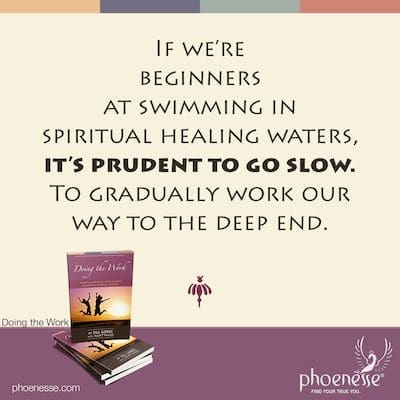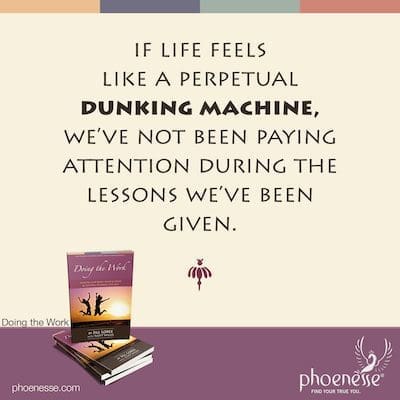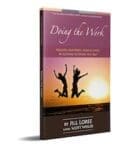Step, Together, Step

Doing the work of healing our fractured, world-weary selves is both linear and nonlinear. The process is often two steps forward and one step back. Consider that no one who has ever executed an elegant dive off a diving board got there without first splashing around in the shallow end. And then somewhere along the way it becomes no big deal to just approach the board and slip into the water—without even having gotten wet first.
But if we’re beginners at swimming in spiritual healing waters, it’s prudent to go slow. We need to learn the ropes and gradually work our way toward lolling in the deep end. No one needs to be thrown in over their head to see what happens. As this analogy goes, that’s a good way to set someone back a fair bit in their learning process.
So while we’re going to need to learn to dance with duality along the way, doing our work isn’t a sink-or-swim situation. This is an important point to take in. Because managing our expectations appropriately can go a long way in keeping us from coming unglued when the going gets tough. And make no mistake, at some point it will. But it’s entirely possible to keep ourselves upright through rough territory, especially if we know that getting water up our nose is a natural part of the learning and growing process.
Even though it’s not entirely linear, this spiritual work of healing has an additive nature to it. Do step one, then add step two. Do one and two, then add step three. This means we need to start wherever we are and grapple with what’s in front of us. Once we are stable enough to stay upright and afloat, we will naturally become ready to move toward deeper work, with some not-unexpected slipping and sliding along the way.

All of that said, our work is already underway and has been since the day we arrived. (And probably for a few lifetimes before this one, to boot.) To say we are now ready to start doing the work is really saying we are ready to take on our work with conscious intention. Rather than letting life have its way with us—as it will—we’re going to face our challenges head-on, going at them with all the goodwill we can muster and getting all the goodie from them we can.
For life is going to teach us the lessons we need to learn, whether we like it or not. And to be fair, on another level, before we arrived at Earth school, we agreed to this. We knew we had some areas of our spirit in need of remedial work. And we came here to sort ourselves out. We took on a task to reconnect some more of our fragmented bits that fractured during our fall from God’s grace. (See more in Holy Moly: The Story of Duality, Darkness and a Daring Rescue).
Also know this: if life feels like it’s a perpetual dunking machine, we’ve not been paying attention during the lessons we’ve been given. And that’s why we may now feel we’re in over our heads. For there is a spiritual law that says we are always given the easiest possible way to deal with any challenge our soul needs to go through for healing. If our way has become choppy, it’s only because we didn’t make much effort when less effort would have been required. Now it’s gotten harder. The struggles and difficulties—due to the Law of Cause and Effect—keep amping up. And we want to continue to blame our way out of our problems. So it is that we typically begin doing our work by lamenting that—poor me—we’re a victim.
In Jill’s Experience
I was 26 years old the day I went to my first AA meeting. It was 1989 and I had just come back from a business trip during which I had enjoyed my very last drink. I’d spent an evening in the bar of a Holiday Inn where I could drink to my heart’s content and not have to drive home. I cringe even now over my memory of the evening. Seemed like such a good gig at the time, but also a sad way to be living my life.
I can’t say I hadn’t seen this coming. I’d been dodging giving up drinking for several years. And truth be told, this was the track I was on since the day I took my very first drink at the age of 13. Yet on the day I picked up my first and only white chip of surrender, I fortunately had a lot of “yets” remaining in my pocket. I hadn’t lost a job yet. I hadn’t messed up my children yet—in fact, I hadn’t had any kids yet. And although I had gone through one marriage already, I hadn’t lost a house yet. All things considered, I was grateful. It could have been worse.
One thing that hastened my entry into sobriety was the exposure I’d had to the evils of alcoholism by way of my father’s slippery slope. I had been in sixth grade when he went through treatment for the first of four rounds. As one can imagine, there was much slipping and sliding in between admissions, and I saw every single one of his relapses coming. More aptly, I felt them, and it sure didn’t feel good.
You’d think a person would avoid those spirits-in-a-bottle altogether then, wouldn’t you? But no, that’s not the way alcoholism rolls. I have no commentary about the nature-versus-nurture aspects of my genetic predisposition to becoming an alcoholic. I only know I was glad they were saving a chair for me when I got there. Because upon arrival, I was inwardly a mess, humiliated by my behavior and befuddled about how to change it. As they say, my best thinking had gotten me to the doorstep of Alcoholics Anonymous, but that was the best place in the world I could have wound up.
For fifteen years I would show up every week to an AA meeting. I liked the things they said that helped me find some semblance of self, like “AA is not a place for bad people who need to get good, it’s a place for sick people who need to get well.” I heard, “There’s a God-shaped hole in my soul that the wind blows through,” and I thought, “These people get me.”
It’s like they were talking straight at me when they said, “Take the cotton out of your ears and put it in your mouth,” and “Don’t drink, even if your ass falls off.” Another of my favorites: “Want to become an old-timer in AA? Don’t drink and don’t die.” Their wisdom flowed like water into my soul, and I was parched.
I went to meetings every week because I needed to hear what happened to people who didn’t go to meetings. Also, I went because I needed to learn how a person copes with life sober—people who drink, they pointed out, have a “broken coper”—and I went because my way hadn’t worked. I arrived in a state of humiliation, and stayed because they were teaching me true humility.
I was an atheist the day I first walked through those doors. Yes, I thought perhaps there actually is a God who had built this place. But he had long ago turned his back on us—or at least he had on me—and had just said, “Go.” As such, I felt I had been on my own since the beginning. So although I didn’t have a God-connection of my own, I didn’t believe these people were making things up when they spoke of having found their own connection to a Higher Power. I wanted that. I was willing to keep hanging out to see if one day I too might find something I could believe in, including myself.
In Scott’s Experience
I was about 13 when I saw the first-ever televised coverage of the Ironman triathlon. It hit me like a bolt from nowhere. I still remember sitting there in the room, watching. I knew right then and there that I was going to do that; that I would be an Ironman. Through high school, then college, then grad school, that urge was always in the back of my mind. I swam, rode and ran in the background as best I could while completing my degrees. After finishing grad school, I made a five-year plan to get to Hawaii: build a base for three years, then a half-Ironman, then Ironman. I was going to tattoo the Ironman logo above my ankle.
I started with 15 training hours per week the first year, growing to 20-25 hours per week by year four. When the summer racing season finished, I’d take a very short break and begin base training for the following year. I was hungry and relentless and developed a sharpened focus to keep pushing through the fatigue and discomfort. And there was A LOT of fatigue and discomfort. After 30+ short distance races, I finished a half-Ironman on a hot August Sunday. I was ready. I signed up for an Ironman race the next year.
The “crash” the following year was sudden and I didn’t see it coming. I went from being able to run six miles at any time, no matter what else I had done that day, to—bang!—not having the energy to walk up the stairs. My autonomic nervous system and endocrine systems went haywire, unable to control my pulse, body temperature and most basic functions.
At work, I would stay at my desk all day because walking to the bathroom was so taxing. Still, even then, I could not let go of the dream of Ironman. I was angry with my body. Doctors couldn’t figure it out any better than I could, and I had to confront the possibility that I might not recover.
Eventually, after all traditional-medicine recourses failed, I realized I needed more than to just heal my body. I needed to understand why I did this to myself, so if I did get better I would not repeat it in another way. At age 30 I took out a piece of paper and wrote: “I am going to heal myself, mentally, physically, emotionally and spiritually, as deep as I can go.” I drew a little boat sitting on the water’s surface and drew little streamers down into the unknown depths for each category, and focused all my relentlessness into healing.
Of course, I had no idea how to do this. None whatsoever. I had been studying Tai Chi Ch’uan for six years, so I asked my instructor if she had any ideas. She advised me to sit for an hour every day, and breathe through my hui yin energy center. (The hui yin in Chinese medicine is known in India as the root chakra).
The point is located roughly halfway between the anus and genitals, and I would sit up-right and visualize I had a tube running up from my root chakra into my lungs. As I breathed in, I would visualize air flowing into this chakra and up into my lungs, then reversed on the out-breath. Nothing much happened for a long time. But, I couldn’t physically do anything other than sit, and had no other options, so I persisted and kept my commitment to healing.
After three months I felt a tingling sensation at my hui yin that I had never experienced before. I went back excitedly to my teacher to tell her the news. She just nodded and told me to continue. That was all. Two weeks later, she simply told me to now breathe through another place, and she touched my back in my lower lumbar to show me. Again nothing happened for a long time.
Since I could still do little other than sit, and had little other option, I kept at it. Two months later, I reported a tingling. She simply nodded and touched another place in my lower back. After another couple months of practice, I felt a tingling there plus two new places I had not been told of. I continued and after a year I had the most basic opening and awareness of all my chakras. It was my first step in a now two-decade long experiential learning of the human energy field.
To say this was mind-blowing, for an engineer no less, is an understatement. I needed to have this ground-shifting experience to break open fixed ideas I held about life. This was my slow process of stabilizing. Open chakras pull a lot of new information in from the world, and it takes time to metabolize the changes.
People often ask me how to become energetically aware, and I tell them to practice breathing through their hui yin. I have not had a single person come back to me. No wonder. In our fast-paced Western lifestyle, I doubt I would have had the discipline to stay with the meditation without being in such a critical situation with my health.
It took a few years, but I came to understand my experience physically, mentally, emotionally and spiritually. I eventually found a doctor who figured it out physically. It seems that although I willed myself to compete in triathlon, unfortunately nobody asked my body. Physiologically I was born with enough fast-twitch muscles to specialize at running the mile, not to go 144 miles in the Ironman.
Crudely simplifying things, I was training at too fast a pace, using too much fast twitch muscle, eating too many carbs to load my tank again, and crucially, creating too much acid waste in my blood stream. The body uses alkalinizing minerals such as calcium and potassium to buffer acids in the blood, until it can’t anymore. Then the body shuts down. It took me many years to alkalize my system again.
On a deeper emotional and spiritual level, it took a little longer. Why did I push myself so hard through such deep fatigue? In the Pathwork lectures there is a concept called an image, which we will discuss in a later chapter. My image here: “If I am strong, I will be loved.” What better way to show I am strong than via Ironman?
Looking back, sitting on the floor at age 13, I watched those athletes drive themselves to exhaustion, to finish and fall into the arms of their loved ones who were cheering them on and who were so excited to receive them. So I drove myself relentlessly in order to show myself and others I am strong, mostly in order to be loved. It was a misguided notion, which obviously didn’t work. But that is the nature of unconscious images.
The deeper meaning of our story rarely comes out right away when we first start out on a path. I could never have discovered my hidden wrong belief regarding how to go about getting love without a slow process of seeing myself. It takes time and patience, but eventually—if we proceed, step by step—a picture starts to come into focus that makes sense.
Next Chapter
Return to Doing the Work Contents


